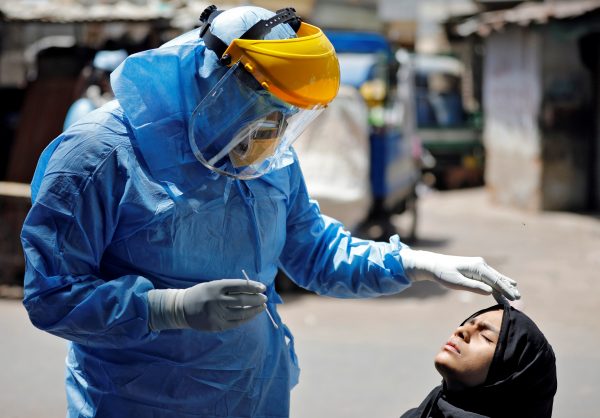On 25 March, the central government announced a 21-day nationwide lockdown that closed all establishments. India’s production systems will remain paralysed for weeks. The lockdown is adversely affecting a very large share of India’s workforce, including migrant labourers working in factories and construction sites. This section of the workforce has lost their livelihoods and is staring at a bleak future.
Still, enterprises in the exports sector recently requested to continue functioning with reduced manpower. A smaller workforce would allow businesses to maintain social distancing in factories, a critical element in the fight against COVID-19. This is a well-considered step for India’s enterprises that face long-term economic hardships amid the withdrawal of global markets in the Asia Pacific. India is still seeking to reach parity with the major regional economies that are already significantly integrated through value chains.
India relies on countries in the Asia Pacific to fight the epidemic in the short-term and for the revival of its economy over the medium-term. India depends heavily on China for intermediate and final products — COVID-19’s bruising impact on the Chinese economy will adversely affect India too. China’s manufacturing sector declined by nearly 14 per cent in February 2020 and exports declined by over 17 per cent.
The pharmaceutical industry is one key industry in India that will be particularly affected. This industry relies heavily on imports of active pharmaceutical ingredients (APIs) from China. During the 2018–19 financial year, more than 80 per cent of India’s API imports were of Chinese origin. India’s import dependence on China in several critical medicines is even higher — 90 per cent for penicillin and 95 per cent for rifampicin and ciprofloxacin.
There are indications that the government is exploring alternative sources of supply for APIs, but this will be difficult. China has a large share in the global production of several APIs, and India’s large demand for these intermediates makes it difficult to find alternative suppliers. China also has a natural advantage as a supplier to Indian producers due to low prices.
But plenty of opportunities remain for regional cooperation that might soften the pandemic’s impact. Significant efforts are underway on three fronts — prevention, mitigation and effective medication. There is no doubt that most countries fell short in their respective preparedness, making collaboration between countries and their agencies the only way forward.
Creating a vaccine will be of vital importance in fighting COVID-19. Scientists from several countries including the United States, Europe, China, Singapore and India are working towards developing vaccines — an area that would benefit immensely from collaboration. Countries in the Asia Pacific need to put in place transparent and open platforms to disseminate the results of vaccine research urgently and efficiently for production and testing to begin. India could become an important link in this collaborative chain, given its experience in developing cost-effective vaccines resulting in the eradication of diseases like smallpox and polio.
Providing adequate test kits to mitigate COVID-19 infection is a major challenge for most governments. While adequate production capacities for test kits exist in the region, governments are not coordinating well enough to ensure that enough kits are available at the right time and in the right places. Despite recognising the importance of tests to isolate carriers of COVID-19, India’s shortage of test kits is forcing its healthcare system to provide only limited testing. Without comprehensive testing of the population, there are significant risks of spreading the disease through community transmission.
India has finally turned to several firms in the Asia Pacific to supply test kits. Sourcing more kits to expand testing seems to be the only way for India to overcome the COVID-19 challenge. Ideally, the government should have in place an extensive system for screening those affected by the virus and isolating them. This would have reduced the risk of community transmission considerably, and a country-wide lockdown could have been avoided.
The existing network of medicine producers in the region, combined with India’s role as a hub for producing cheap generic medicine, can provide a long-term solution for treating infected patients. Networks in the Asia Pacific region have so far focussed on specific industries to fuel economies. The COVID-19 challenge has now alerted regional governments that they must address systemic issues in the healthcare sector by building effective and collaborative networks across their agencies and industries. The long-term stability of many economies in this region critically hinges on their ability to do so.
Biswajit Dhar is Professor at the Centre for Economic Studies and Planning in the School of Social Sciences, Jawaharlal Nehru University, Delhi.
This article is part of an EAF special feature series on the novel coronavirus crisis and its impact.


A well-balanced account on the COVID-19 and India’s preparedness and its role in collaborative networks.
World has witnessed several epidemics of this kind and the death toll would have been more. But, as is understood from the reports, there exists a fear that Covid-19 would threaten every aspect of human life. As is known well, It has already set a chain of reactions in motion. No doubt, it is disastrous. It’s high time for all the countries, especially the major ones, to embark on a strategy of collaboration and cooperation in pursuit of combating the catastrophes of this kind in the future. If governments in power fail to provide health security, would it be possible for the populace to get equipped on its own.